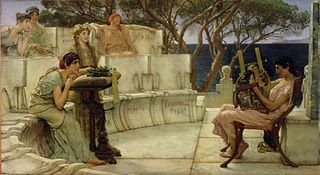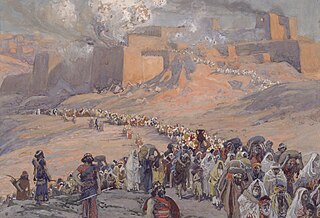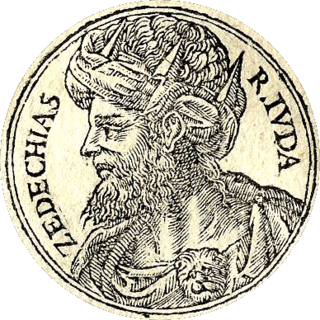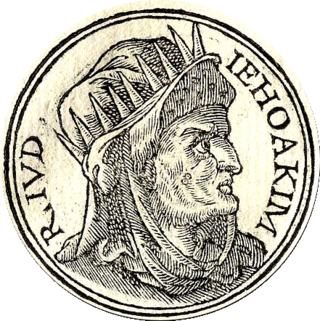Related Research Articles
The 6th century BC started on the first day of 600 BC and ended on the last day of 501 BC.

This article concerns the period 599 BC – 590 BC.

The Babylonian captivity or Babylonian exile was the period in Jewish history during which a large number of Judeans from the ancient Kingdom of Judah were forcibly relocated to Babylonia by the Neo-Babylonian Empire. The deportations occurred in multiple waves: After the siege of Jerusalem in 597 BCE, around 7,000 individuals were deported to Mesopotamia. Further deportations followed the destruction of Jerusalem and Solomon's Temple in 587 BCE.

Zedekiah was the twentieth and final King of Judah before the destruction of Jerusalem by Nebuchadnezzar II of Babylon. His birth name was Mattaniah/Mattanyahu.
The year 609 BC was a year of the pre-Julian Roman calendar. In the Roman Empire, it was known as year 145 Ab urbe condita. The denomination 609 BC for this year has been used since the early medieval period, when the Anno Domini calendar era became the prevalent method in Europe for naming years.

Jeconiah, also known as Coniah and as Jehoiachin, was the nineteenth and penultimate king of Judah who was dethroned by the King of Babylon, Nebuchadnezzar II in the 6th century BCE and was taken into captivity. He was the son and successor of King Jehoiakim, and the grandson of King Josiah. Most of what is known about Jeconiah is found in the Hebrew Bible. Records of Jeconiah's existence have been found in Iraq, such as the Jehoiachin's Rations Tablets. These tablets were excavated near the Ishtar Gate in Babylon and have been dated to c. 592 BCE. Written in cuneiform, they mention Jeconiah and his five sons as recipients of food rations in Babylon.
The year 634 BC was a year of the pre-Julian Roman calendar. In the Roman Empire, it was known as year 120 Ab urbe condita. The denomination 634 BC for this year has been used since the early medieval period, when the Anno Domini calendar era became the prevalent method in Europe for naming years.

Jehoiakim, also sometimes spelled Jehoikim was the eighteenth and antepenultimate King of Judah from 609 to 598 BC. He was the second son of King Josiah and Zebidah, the daughter of Pedaiah of Rumah. His birth name was Eliakim.

Kiriath-Jearim was a city in the Land of Israel. It is mentioned 18 times in the Hebrew Bible. The biblical place was identified with Abu Ghosh.

Matthew 1:11 is the eleventh verse of the first chapter of the Gospel of Matthew in the New Testament. The verse is part of the section where the genealogy of Joseph, the father of Jesus, is listed. It is the last verse of the middle third of the listing.

The Kings of Judah were the monarchs who ruled over the ancient Kingdom of Judah, which was formed in about 930 BC, according to the Hebrew Bible, when the United Kingdom of Israel split, with the people of the northern Kingdom of Israel rejecting Rehoboam as their monarch, leaving him as solely the King of Judah.

The siege of Jerusalem was the final event of the Judahite revolts against Babylon, in which Nebuchadnezzar II, king of the Neo-Babylonian Empire, besieged Jerusalem, the capital city of the Kingdom of Judah. Jerusalem fell after a 30-month siege, following which the Babylonians systematically destroyed the city and Solomon's Temple. The Kingdom of Judah was dissolved and many of its inhabitants exiled to Babylon.

The siege of Jerusalem was a military campaign carried out by Nebuchadnezzar II, king of the Neo-Babylonian Empire, in which he besieged Jerusalem, then capital of the Kingdom of Judah. The city surrendered, and its king Jeconiah was deported to Babylon and replaced by his Babylonian-appointed uncle, Zedekiah. The siege is recorded in both the Hebrew Bible and the Babylonian Nebuchadnezzar Chronicle.
This is a timeline of the development of prophecy among the Jews in Judaism. All dates are given according to the Common Era, not the Hebrew calendar.

2 Kings 24 is the twenty-fourth chapter of the second part of the Books of Kings in the Hebrew Bible or the Second Book of Kings in the Old Testament of the Christian Bible. The book is a compilation of various annals recording the acts of the kings of Israel and Judah by a Deuteronomic compiler in the seventh century BCE, with a supplement added in the sixth century BCE. This chapter records the events during the reigns of Jehoiakim, Jehoiachin and Zedekiah, kings of Judah.

2 Chronicles 36 is the thirty-sixth chapter of the Second Book of Chronicles the Old Testament of the Christian Bible or of the second part of the Books of Chronicles in the Hebrew Bible. The book is compiled from older sources by an unknown person or group, designated by modern scholars as "the Chronicler", and had the final shape established in late fifth or fourth century BCE. This chapter belongs to the section focusing on the kingdom of Judah until its destruction by the Babylonians under Nebuchadnezzar and the beginning of restoration under Cyrus the Great of Persia. It contains the regnal accounts of the last four kings of Judah - Jehoahaz, Jehoiakim, Jehoiachin and Zedekiah - and the edict of Cyrus allowing the exiled Jews to return to Jerusalem.

Jeremiah 22 is the twenty-second chapter of the Book of Jeremiah in the Hebrew Bible or the Old Testament of the Christian Bible. This book contains prophecies attributed to the prophet Jeremiah, and is one of the Books of the Prophets.

Jeremiah 26 is the twenty-sixth chapter of the Book of Jeremiah in the Hebrew Bible or the Old Testament of the Christian Bible. It is numbered as Jeremiah 33 in the Septuagint. This book contains prophecies attributed to the prophet Jeremiah, and is one of the Books of the Prophets. This chapter contains an exhortation to repentance, causing Jeremiah to be apprehended and arraigned ; he gives his apology, resulting the princes to clear him by the example of Micah and of Urijah, and by the care of Ahikam.

Jeremiah 35 is the thirty-fifth chapter of the Book of Jeremiah in the Hebrew Bible or the Old Testament of the Christian Bible. It is numbered as Jeremiah 42 in the Septuagint. This book contains prophecies attributed to the prophet Jeremiah, and is one of the Books of the Prophets. This chapter records the meeting of Jeremiah with the Rechabites, a nomadic clan, in which the prophet "contrast[s] their faithfulness to the commands of a dead ancestor with the faithlessness of the people of Judah to the commands of a living God".
References
- ↑ E.J. Bickerman, Chronology of the Ancient World (Ithaca: Cornell University Press, 1968), p. 198